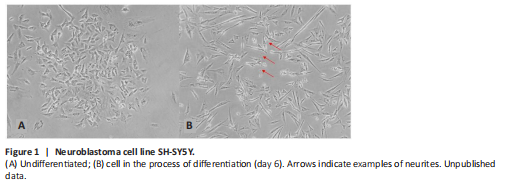神经退行性病
-
Figure 1|Neuroblastoma cell line SH-SY5Y.

Originating from the SK-N-SH cell subline (established from a bone marrow biopsy of a 4-year-old female child), the neuroblastoma cell line SH-SY5Y (Figure 1A) is a largely immortalized cell line used in in vitro models of neurological disorders, including Alzheimer’s disease (AD), neurotoxicity, ischemia, and amyotrophic lateral sclerosis (Xicoy et al., 2017; Peng et al., 2021). As they are human-derived, they express several human-specific proteins and protein isoforms that are not inherently present in primary rodent cell cultures (Kovalevich and Langford, 2013). The strain shows moderate dopamine-β-hydroxylase activity and insignificant levels of choline acetyltransferase, acetylcholinesterase, butyryl-cholinesterase, basal norepinephrine and tyrosine hydroxylase activity. Tyrosine hydroxylase, the rate-limiting enzyme in the catecholamine synthesis pathway, converts tyrosine to L-DOPA, the precursor of dopamine, which is converted to norepinephrine by dopamine-β-hydroxylase. Therefore, the SH-SY5Y cell line may exhibit a catecholaminergic phenotype because it can synthesize both dopamine and norepinephrine (Xicoy et al., 2017).
To mimic the effects of drug treatment and/or genetic approaches on the progression of Parkinson’s disease (PD), the expression of candidate genes (obtained from genetic studies in families with PD) may be studied using the cell line. For example, 1-methyl-4-phenylpyridinium (MPP+), 6-hydroxydopamine, and rotenone can alter multiple cellular pathways, affecting mitochondrial dysfunction and oxidative stress (Xicoy et al., 2017).
Moreover, SH-SY5Y cells can be induced to differentiate (Figure 1B) into a more mature, neuron-like phenotype by manipulating the culture medium, allowing large-scale expansion even before differentiation, presenting a low-cost option compared to primary neurons, and obviating the ethical concerns associated with primary human neuronal culture. However, SH-SY5Y cells also have limitations, such as their limited relevance in modeling actual neurons. As it is derived from neuroblastoma, this cell line has cancer-like properties that influence its differentiation fate, viability, growth performance, metabolic properties, and genomic stability. Therefore, in the case of PD, for example, SH-SY5Y cells are not purely ADergic, presenting characteristics that are quite different from normal ADergic neuronal characteristics (Xicoy et al., 2017). The cell line can be compared to embryonic stem cell- or induced pluripotent stem cell-derived human neurons. Unlike primary neurons, induced pluripotent stem cell-derived neurons are easy to obtain and propagate, similar to SH-SY5Y. Unlike SH-SY5Y, their differentiation is more costly and more time-consuming—however, as a tradeoff, they do show a more relevant neuron-like phenotype and will therefore make a better model for many applications, such as the modeling of neurological disorders with a genetic background, general toxicity studies, mimicking axonal degeneration, and electrophysiological studies (Yamanaka, 2020).